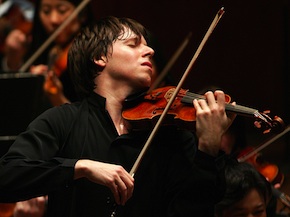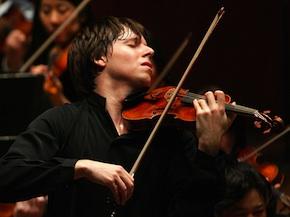
In his second of three "Project San Francisco" appearances this year, Joshua Bell gave a recital this Thursday at Davies Symphony Hall. The program consisted of mostly general repertoire works — pieces that are heard over and over at conservatories around the world: Beethoven's C Minor Violin Sonata, Eugène Ysaÿe's D Minor solo Sonata, and César Franck's A Major Violin Sonata. Only the Mendelssohn F Major violin sonata, which opened the recital, was a slightly more obscure selection.
This was the kind of recital where the repertoire doesn't much matter. It's not about the composer or which composition is played. People come to see Joshua Bell. He was recently named music director of the legendary Academy of St. Martin in the Fields orchestra, he's one of People Magazine's “50 most beautiful people,” he was that participant in The Washington Post's infamous subway violin-playing experiment; and at age 43, he still makes girls swoon ... high pitched squeals could be heard from the upper tiers.
Related Articles
Joshua Bell Artist Page
Bio, Fun Facts, Video
For Whom Joshua Bell Extols
September 28, 2011
But it's not all charisma: Bell plays in a beautiful manner with elegant movements and natural musicianship. The most amazing aspect of Bell's performance was his bow control. Whether it is crisply articulated strains of staccato up-bows or impeccably smooth melodic lines the bow did Bell's bidding like a magic wand. In some of the slow movements the bow could have been 20-foot-long ribbon — the bow changes were inaudible. Even for rapid multistring stops (there are plenty in the Ysaÿe), Bell maintained a rich, dark sound always refining his phrases with tender care and a graceful taper. Yet he also saved in his quiver some rough, guttural bow strokes for when the sound needs to be more intense and not just "pretty." It was a clinic on the many uses of the violin bow.
Bell's left-hand mastery of the fingerboard is just as staggering as his bow control. His fingers can grab any high note and any chord at any speed as if it's second nature. Bell's complete mastery of the violin was also facilitated by his foot work. Throughout the evening Bell literally danced on stage. He rocked back and forth, bending his knees and back down then springing up straight to emphasize the downbeats, sweat and hair flying all around, all while playing rapid leaps and scales. He would lean diagonally on his left leg while extending his right leg so that his pointed right toe is barely touching the stage — like a ballerina and seemingly hanging in the balance — and then switch legs extending to the other side, always in alignment with subdivisions of the musical phrase.
Pianist Sam Haywood kept up with Bell but there wasn't a whole lot of communication between the two. This was especially problematic in the Beethoven sonata, which requires more than just thrilling indulgence in violin playing. Beethoven's lines are passed around between the violin and piano in a way that requires meaningful hand-offs. Sometimes the right hand of the piano and the violin are in parallel sixths — this needs to be carefully coordinated but it was only roughly together, not a unified entity. Joshua Bell is a soloist, not a chamber musician.
Haywood read his music from an iPad, turning pages with a wireless foot pedal. In contrast to Bell, he kept his back firmly in place, fingers blazing with nimble strength, always careful not to step on the star’s toes.
For an encore, the duo performed Bell's own arrangement of Chopin’s nocturne in C-sharp Minor. In the arrangement, the violin plays the melodic right hand, while the piano plays the original left-hand material with perhaps some added notes. Possibly the highlight of the program, it was the perfect selection with which to say good-night to Bell’s sweetest lullaby tone. The rapid flurries that Chopin notates as strings of ad-lib grace notes sounded like fairy dust on the violin, and Bell surprised by reaching even higher in the stratosphere of the violin’s range, adding a few extra high frills before coming back in with the hearty Polish melody.

